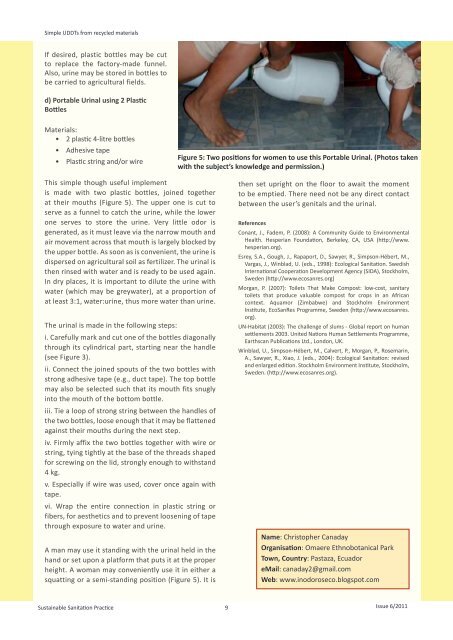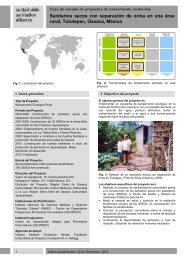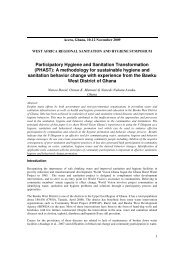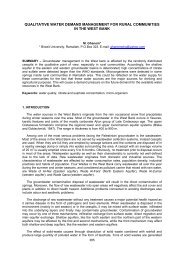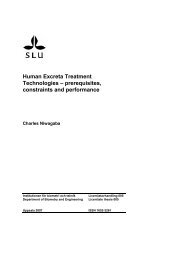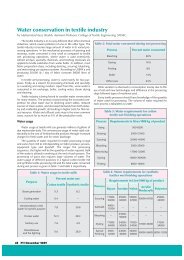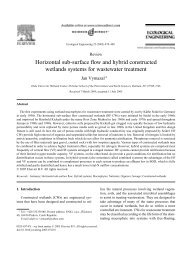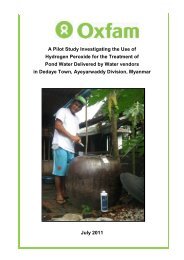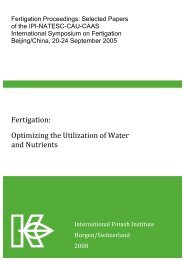Experiences with urine diverting dry toilets - EcoSan Club
Experiences with urine diverting dry toilets - EcoSan Club
Experiences with urine diverting dry toilets - EcoSan Club
You also want an ePaper? Increase the reach of your titles
YUMPU automatically turns print PDFs into web optimized ePapers that Google loves.
Simple UDDTs from recycled materials<br />
If desired, plastic bottles may be cut<br />
to replace the factory-made funnel.<br />
Also, <strong>urine</strong> may be stored in bottles to<br />
be carried to agricultural fields.<br />
d) Portable Urinal using 2 Plastic<br />
Bottles<br />
Materials:<br />
• 2 plastic 4-litre bottles<br />
• Adhesive tape<br />
• Plastic string and/or wire<br />
This simple though useful implement<br />
is made <strong>with</strong> two plastic bottles, joined together<br />
at their mouths (Figure 5). The upper one is cut to<br />
serve as a funnel to catch the <strong>urine</strong>, while the lower<br />
one serves to store the <strong>urine</strong>. Very little odor is<br />
generated, as it must leave via the narrow mouth and<br />
air movement across that mouth is largely blocked by<br />
the upper bottle. As soon as is convenient, the <strong>urine</strong> is<br />
dispersed on agricultural soil as fertilizer. The urinal is<br />
then rinsed <strong>with</strong> water and is ready to be used again.<br />
In <strong>dry</strong> places, it is important to dilute the <strong>urine</strong> <strong>with</strong><br />
water (which may be greywater), at a proportion of<br />
at least 3:1, water:<strong>urine</strong>, thus more water than <strong>urine</strong>.<br />
The urinal is made in the following steps:<br />
i. Carefully mark and cut one of the bottles diagonally<br />
through its cylindrical part, starting near the handle<br />
(see Figure 3).<br />
ii. Connect the joined spouts of the two bottles <strong>with</strong><br />
strong adhesive tape (e.g., duct tape). The top bottle<br />
may also be selected such that its mouth fits snugly<br />
into the mouth of the bottom bottle.<br />
iii. Tie a loop of strong string between the handles of<br />
the two bottles, loose enough that it may be flattened<br />
against their mouths during the next step.<br />
iv. Firmly affix the two bottles together <strong>with</strong> wire or<br />
string, tying tightly at the base of the threads shaped<br />
for screwing on the lid, strongly enough to <strong>with</strong>stand<br />
4 kg.<br />
v. Especially if wire was used, cover once again <strong>with</strong><br />
tape.<br />
vi. Wrap the entire connection in plastic string or<br />
fibers, for aesthetics and to prevent loosening of tape<br />
through exposure to water and <strong>urine</strong>.<br />
A man may use it standing <strong>with</strong> the urinal held in the<br />
hand or set upon a platform that puts it at the proper<br />
height. A woman may conveniently use it in either a<br />
squatting or a semi-standing position (Figure 5). It is<br />
Sustainable Sanitation Practice<br />
Figure 5: Two positions for women to use this Portable Urinal. (Photos taken<br />
<strong>with</strong> the subject’s knowledge and permission.)<br />
9<br />
then set upright on the floor to await the moment<br />
to be emptied. There need not be any direct contact<br />
between the user’s genitals and the urinal.<br />
References<br />
Conant, J., Fadem, P. (2008): A Community Guide to Environmental<br />
Health. Hesperian Foundation, Berkeley, CA, USA (http://www.<br />
hesperian.org).<br />
Esrey, S.A., Gough, J., Rapaport, D., Sawyer, R., Simpson-Hébert, M.,<br />
Vargas, J., Winblad, U. (eds., 1998): Ecological Sanitation. Swedish<br />
International Cooperation Development Agency (SIDA), Stockholm,<br />
Sweden (http://www.ecosanres.org)<br />
Morgan, P. (2007): Toilets That Make Compost: low-cost, sanitary<br />
<strong>toilets</strong> that produce valuable compost for crops in an African<br />
context. Aquamor (Zimbabwe) and Stockholm Environment<br />
Institute, <strong>EcoSan</strong>Res Programme, Sweden (http://www.ecosanres.<br />
org).<br />
UN-Habitat (2003): The challenge of slums - Global report on human<br />
settlements 2003. United Nations Human Settlements Programme,<br />
Earthscan Publications Ltd., London, UK.<br />
Winblad, U., Simpson-Hébert, M., Calvert, P., Morgan, P., Rosemarin,<br />
A., Sawyer, R., Xiao, J. (eds., 2004): Ecological Sanitation: revised<br />
and enlarged edition. Stockholm Environment Institute, Stockholm,<br />
Sweden. (http://www.ecosanres.org).<br />
Name: Christopher Canaday<br />
Organisation: Omaere Ethnobotanical Park<br />
Town, Country: Pastaza, Ecuador<br />
eMail: canaday2@gmail.com<br />
Web: www.inodoroseco.blogspot.com<br />
Issue 6/2011


